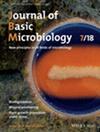封面:Journal of Basic Microbiology. 9/2025
IF 2.7
4区 生物学
Q2 MICROBIOLOGY
引用次数: 0
摘要
封面插图:植物生长促进根瘤菌(PGPR)支持可持续作物生产的直接和间接机制的图形表示。直接机制包括植物激素的产生、生物固氮、磷酸盐的溶解和铁载体的产生,而间接机制包括诱导系统抗性、外多糖(EPS)的产生、渗透物的积累和抗菌化合物的合成。(设计:Aditya Sheershwal,印度鲁尔基母亲大学理学院)本文章由计算机程序翻译,如有差异,请以英文原文为准。

Cover: Journal of Basic Microbiology. 9/2025
Cover illustration:
Graphical representation of direct and indirect mechanisms employed by plant growth-promoting rhizobacteria (PGPR) to support sustainable crop production. Direct mechanisms include phytohormone production, biological nitrogen fixation, phosphate solubilization, and siderophore production, while indirect mechanisms involve induction of systemic resistance, exopolysaccharide (EPS) production, osmolyte accumulation, and antimicrobial compound synthesis.
(Design: Aditya Sheershwal, Faculty of Science, Motherhood University, Roorkee, India)
求助全文
通过发布文献求助,成功后即可免费获取论文全文。
去求助
来源期刊

Journal of Basic Microbiology
生物-微生物学
CiteScore
6.10
自引率
0.00%
发文量
134
审稿时长
1.8 months
期刊介绍:
The Journal of Basic Microbiology (JBM) publishes primary research papers on both procaryotic and eucaryotic microorganisms, including bacteria, archaea, fungi, algae, protozoans, phages, viruses, viroids and prions.
Papers published deal with:
microbial interactions (pathogenic, mutualistic, environmental),
ecology,
physiology,
genetics and cell biology/development,
new methodologies, i.e., new imaging technologies (e.g. video-fluorescence microscopy, modern TEM applications)
novel molecular biology methods (e.g. PCR-based gene targeting or cassettes for cloning of GFP constructs).
 求助内容:
求助内容: 应助结果提醒方式:
应助结果提醒方式:


